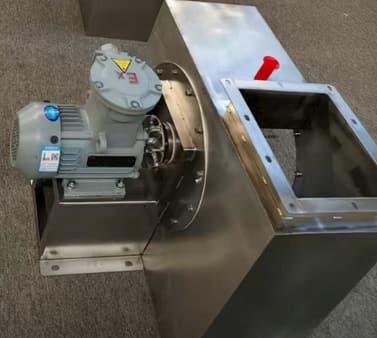HVAC Fans in Modern HVAC Systems
What Is an HVAC System?
An HVAC (Heating, Ventilation, and Air Conditioning) system is the central infrastructure responsible for maintaining indoor air quality, temperature, and humidity in buildings. From residential homes and commercial buildings to industrial facilities and transportation infrastructure, HVAC systems are vital to creating a comfortable, safe, and energy-efficient environment. Within this complex system, the HVAC fan plays a critical role as the driving force behind air movement and pressure control.
Core Components of an HVAC System
An HVAC system consists of multiple interconnected subsystems. The main components include:
Heating units (boilers, furnaces, heat pumps)
Cooling units (chillers, cooling towers)
Air handling units (AHUs), fan coil units (FCUs)
Ductwork and air distribution systems
Control systems and thermostats
Ventilation and exhaust systems, including fans
Among these, HVAC fans are integral to both everyday ventilation and emergency smoke control functions. They determine how air is distributed throughout the building, ensuring proper air exchange and maintaining indoor air quality.
Classification of HVAC Fans
HVAC fans come in various types, each designed for specific operational conditions. The major categories include:
Axial Fans: Ideal for high-volume, low-pressure applications such as general ventilation.
Centrifugal Fans: Used where higher pressure is needed, such as ducted systems and filtration.
Mixed Flow Fans: Combine the features of axial and centrifugal fans for medium-pressure applications.
Jet Fans: Used in tunnels and parking garages for smoke extraction and ventilation.
Cabinet Fans: Versatile units integrated into AHUs or standalone ventilation boxes.
Each type of fan has unique aerodynamic characteristics that impact system efficiency, airflow distribution, and noise levels.
Functions of HVAC Fans
1. Air Distribution and Circulation
HVAC fans ensure uniform air distribution across all rooms and floors in a building. They facilitate the movement of conditioned air (heated or cooled) from the central unit to various spaces via ductwork.
2. Fresh Air Supply and Exhaust
In modern high-performance buildings, proper ventilation is essential. HVAC fans supply fresh air while simultaneously exhausting stale air, CO₂, VOCs (volatile organic compounds), and odors.
3. Humidity and Temperature Control
By enabling airflow across coils and dehumidification systems, HVAC fans indirectly influence humidity control and temperature uniformity across the conditioned space.
4. Smoke Extraction and Fire Safety
Specialized smoke exhaust fans and pressurization fans form the backbone of smoke management systems in emergency conditions, particularly in basements, tunnels, and stairwells.
The Strategic Importance of HVAC Fans in System Performance
The performance of an HVAC system is deeply influenced by fan efficiency, pressure characteristics, and integration with control systems.
Energy Efficiency
HVAC fans can consume up to 30-50% of the total energy used in commercial HVAC systems. Choosing high-efficiency fan designs (e.g., backward-curved centrifugal fans) with variable frequency drives (VFDs) can result in substantial energy savings.
Fire Safety Compliance
In critical infrastructure such as metro stations, tunnels, or high-rise buildings, the smoke control fan system is legally required. High-temperature smoke exhaust fans must meet fire resistance certifications (e.g., 300°C/2h), directly impacting building code compliance and life safety strategies.
Integration with Building Systems
Modern HVAC fans often integrate with Building Management Systems (BMS), allowing for real-time monitoring, load-based operation, and fault detection. This not only improves energy performance but also supports predictive maintenance.
HVAC Fans in Different Applications
Commercial Buildings
In malls, hotels, and office towers, cabinet fans, rooftop exhaust fans, and fresh air units provide reliable air circulation and noise control.
Industrial Facilities
Factories and manufacturing plants require high-volume industrial centrifugal fans for dust extraction, fume control, and process ventilation.
Transportation Infrastructure
Metro stations, tunnels, and underground garages deploy jet fans, axial smoke fans, and pressurization units for emergency egress support during fires.
Healthcare & Clean Rooms
In hospitals and labs, HVAC fans ensure laminar flow, maintain pressurization levels, and reduce airborne contaminants.
How SHUANGYANG FAN Enhances HVAC Systems
As a top-tier Chinese manufacturer of ventilation and smoke exhaust fans, Zhejiang Shuangyang Fans Holding Co., Ltd delivers a wide range of HVAC fan solutions:
Axial fans for large airflow requirements
Mixed flow fans for balanced pressure and volume performance
Backward centrifugal fans / Cabinet fans for ducted systems
Roof fans for rooftop ventilation or fume extraction
Jet fans for tunnels and car parking ventilation and fire smoke control
Smoke exhaust fans for fire protection systems
Besides, read more for all fan categories and details.
These products are widely used in subways, tunnels, nuclear power stations, commercial complexes, high-rise buildings and industrial plants. SHUANGYANG FAN emphasizes high efficiency, compliance with safety standards, and customizable configurations to fit diverse HVAC system needs.
Future Trends: Intelligent and Sustainable HVAC Fans
The industry is moving toward intelligent, connected fan systems that:
Adjust speed automatically based on real-time demand
Monitor system health via IoT-enabled sensors
Minimize energy use while maximizing comfort and safety
HVAC fan design is also increasingly influenced by sustainability metrics such as FEI (Fan Energy Index), promoting the use of fans that provide higher airflow per unit of energy consumed.
Conclusion
HVAC fans are not merely components of an HVAC system — they are the heart of airflow management. Whether it’s providing fresh air, ensuring thermal comfort, or saving lives during fire emergencies, HVAC fans are central to system performance, energy efficiency, and safety.
For any building project aiming at long-term value, reliability, and compliance, the selection of the right HVAC fan — in terms of type, efficiency, and application — is a critical engineering decision.
Note: The content of the article cannot avoid omissions and errors. Welcome to propose corrections.
 Mancooler (Workstation) Fans — Why Your Factory Needs the Right One
Mancooler (Workstation) Fans — Why Your Factory Needs the Right One
 Motor Classifications in Industrial Fans
Motor Classifications in Industrial Fans
 Materials for Explosion-Proof Fan
Materials for Explosion-Proof Fan
 Direct Drive vs. Belt Drive in Axial Fan and Centrifugal Fan
Direct Drive vs. Belt Drive in Axial Fan and Centrifugal Fan

